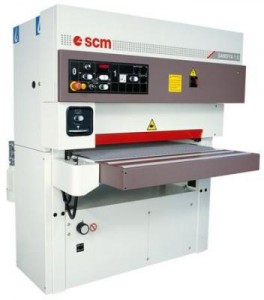 While it’s possible to run a woodworking business without using a sander, it would mean ordering your wood pre-sanded, and potentially pre-cut, which would soon add up to a small fortune. Thankfully, identifying the right sander has less to do with technicalities and more to do with the type of stock you work with and the type of product you produce. For example, furniture maker’s raw stock results in different sanding needs than rough stock whose rawness has been removed. Ultimately, the best way to define sanding needs is to talk about the basic types of sanders that meet them: handheld sanders, commercial grade stationary sanders, and industrial grade stationary sanders.
While it’s possible to run a woodworking business without using a sander, it would mean ordering your wood pre-sanded, and potentially pre-cut, which would soon add up to a small fortune. Thankfully, identifying the right sander has less to do with technicalities and more to do with the type of stock you work with and the type of product you produce. For example, furniture maker’s raw stock results in different sanding needs than rough stock whose rawness has been removed. Ultimately, the best way to define sanding needs is to talk about the basic types of sanders that meet them: handheld sanders, commercial grade stationary sanders, and industrial grade stationary sanders.
1. Handheld
Handheld models are excellent for putting the finishing touches on wood products whose surface finish will be extremely smooth. Otherwise, they’re more sensible to use in woodshop settings than commercial settings due to their low sanding capacity. If you run a small woodshop whose product demand is gradually increasing, start looking for a higher capacity model before you’re forced to buy one on the fly.
2. Commercial Grade
Most commercial grade models offer the advantage of belt sanding, reducing manual labor and sanding stock to the desired degree in a shorter period of time. Commercial models are ideal for the growing woodshop whose small workspace forbids the purchase of an industrial model, or for the commercial operation that holds the value of quality about the value of quantity, resulting in a lower production.
3. Industrial Grade
Industrial models offer the highest capability for sanding raw or rough stock into usable states. But their belt width and generally larger grain sanding belts aren’t intended for the very finest of sanding. Even so, sanding stock with industrial sanders and then putting on the finishing touches with other sanders is a significant time saver that can increase production.
Buying Sanders Used
When shopping for used sanders, it’s best to limit one’s selection to commercial and industrial models, which have the most rigid construction and the longest lifespan. More often than not, the quality of a used sander is determined by its buyer’s diligence in uncovering its quality than by its brand or age. For sanders, as well as for other types of used woodworking machinery, four time-tested tips for buying reliable machinery are: (1) buy from professional sellers of used woodworking machinery and not amateur ones (e.g. certain Craigslist sellers, eBay merchants, and auctioneers); (2) investigate a seller’s business rating at the Better Business Bureau (BBB), avoiding sellers that have unresolved customer complaints; (3) buy equipment with a spotless maintenance history as witnessed by its logged service record; and (4) inspect the equipment firsthand before buying it, or having a trusted third party perform the inspection.




